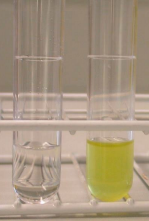Mycobacterium smegmatis (negative for the niacin test)
TESTING PROCEDURES
A niacin test strip is similar in appearance to a pH test strip. It is small, thin, rectangular, and white in color. Water is placed onto the culture plate and touched with a test strip for 15–20 minutes inside a small, sterile tube. If excess amounts of niacin are detected, the liquid inside the tube will turn yellow, a positive test. If the liquid in the tube is clear, there are no excess amounts of niacin and the test is negative. It should be noted that a positive niacin test does not necessarily indicate the presence of M. tuberculosis because other Mycobacterium species can test positive for excess niacin.Along with each batch of specimens being tested, a positive control of M. tuberculosis and a negative control with no organism will be included. If the positive control tests negative, there was probably an error with the batch, and likewise for a negative test showing positive.
 Because lab samples that are determined to be acid-fast bacilli are possibly M. tuberculosis, a biosafety level 3 organism, all niacin tests must be conducted in a biosafety cabinet with a full gown, respirator, gloves, and sealed laboratory to ensure the safety of the lab technologist performing the test. All tests must also be conducted with sterile technique.
Because lab samples that are determined to be acid-fast bacilli are possibly M. tuberculosis, a biosafety level 3 organism, all niacin tests must be conducted in a biosafety cabinet with a full gown, respirator, gloves, and sealed laboratory to ensure the safety of the lab technologist performing the test. All tests must also be conducted with sterile technique.




No comments:
Post a Comment
Due to the high number of spammy comments we have decided to initiate comment moderation so that we can maintain our quality standards and make good environment for our visitors. Please leave your comment